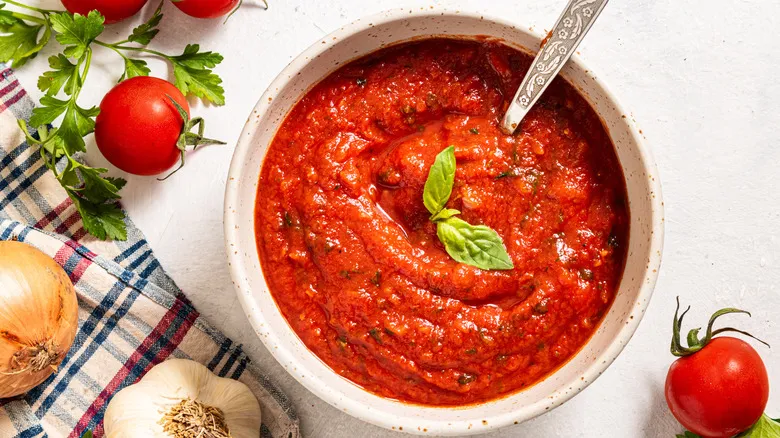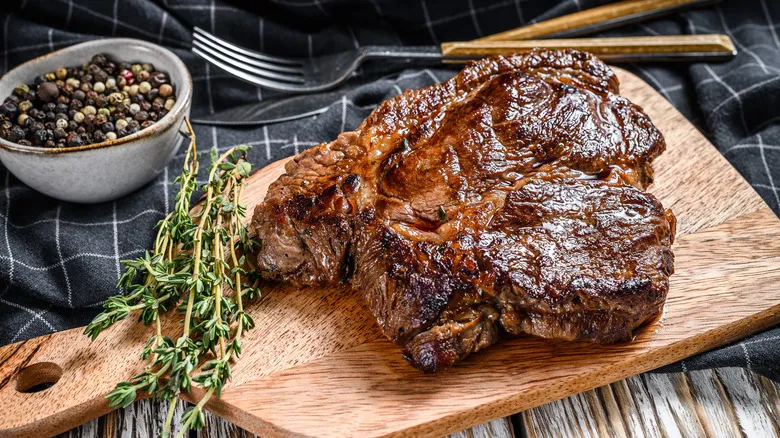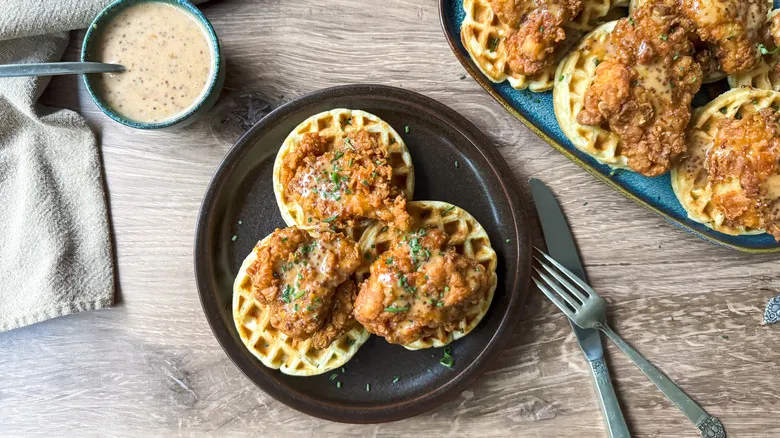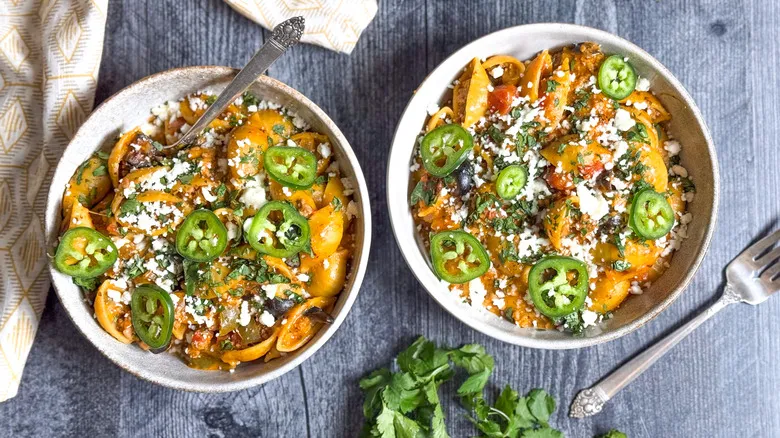Make sure they're evenly sized
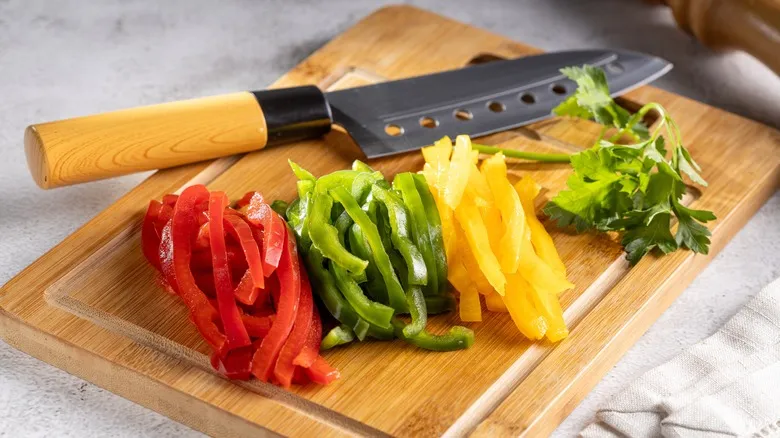
To achieve perfectly grilled vegetables, start with a straightforward yet often overlooked step: cut them into uniform pieces. While it may seem like a minor detail, taking the time to chop your vegetables to a consistent size can greatly enhance your grilling results. Chef Liam O'Connell highlights this: "In my view, the most frequent mistake is having pieces that are either too small or too large. Uniformity ensures even cooking times. Additionally, cutting vegetables to create a flat, even surface prevents them from rolling around, which can lead to uneven cooking."
Chef Greg León concurs, stating, "Inconsistent sizes result in uneven cooking; smaller pieces may burn while larger ones stay undercooked. For instance, slice zucchini into even rounds or cut bell peppers into similarly sized strips." This method promotes even heat distribution, allowing each piece to develop that sought-after char without some being overcooked or underdone. Get your veggies chopped just right, and you'll enjoy consistently delicious, perfectly grilled bites every time.
Don't put salt in the marinade
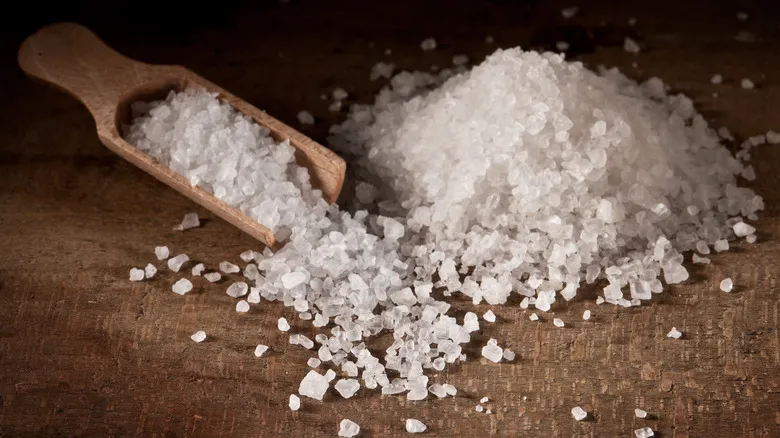
When grilling vegetables, the timing and method of adding salt can significantly impact the outcome. Chef Liam O'Connell recommends avoiding salt in your marinade. "Salt should be added to the vegetables just before they go on the grill," he explains. There are two main reasons for this. Firstly, if salt is included in the marinade, it can make the vegetables too salty if they sit for too long. More importantly, "salt pulls moisture out of the vegetables," O'Connell points out. "When marinating, you want to infuse flavors and moisture, not extract them."
That said, O'Connell acknowledges some exceptions to this guideline. For high-water-content vegetables like eggplant, "seasoning them in advance helps draw out excess moisture, preventing them from becoming mushy" while grilling. This advice also applies to other moisture-rich vegetables such as zucchini, bell peppers, and asparagus. In general, for the best results, it's advisable to follow the initial recommendation of omitting salt from your marinade.
Avoid moving the vegetables much while they're grilling

A frequent error when grilling vegetables is over-manipulating them while they cook. It can be tempting to keep turning them, but Chef Liam O'Connell recommends against this approach. "The key is to be patient and allow the char to form." Constantly moving them can lead to uneven cooking and interfere with the caramelization process, which is where much of the smoky flavor originates.
Instead, place your vegetables on the grill and try to avoid fidgeting. Use this time to focus on other tasks, such as preparing the main course or arranging additional side dishes. During this period, you'll gradually achieve those attractive grill marks and rich flavors. Whether you're grilling robust vegetables like bell peppers and zucchini or more delicate options like asparagus, patience will truly yield great results. So, resist the temptation to micromanage your veggies and leave them undisturbed until it's time to flip them.
Create heat zones on the grill
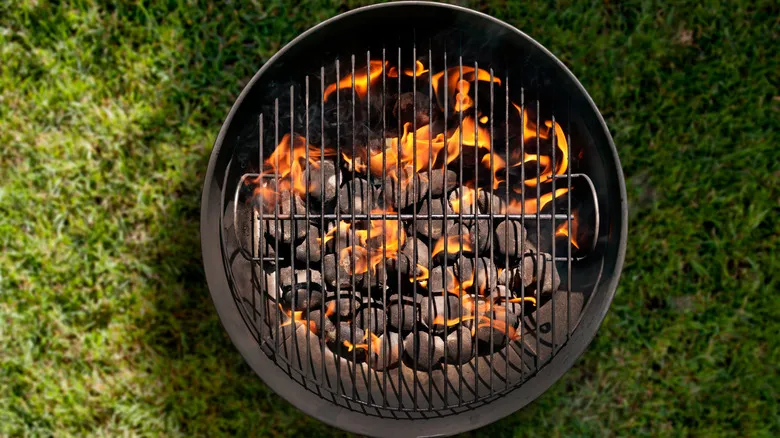
To achieve perfectly grilled vegetables, mastering heat management on your grill is essential. Instead of applying consistent heat throughout, creating distinct heat zones can enhance your vegetable cooking. Liam O'Connell emphasizes the importance of having "a hot side and a cooler side of the grill for this purpose." He suggests starting the vegetables "on the hot side to develop a bit of char, then moving them to the cooler side to prevent overcooking." Chef Greg León adds, "Beginning with direct heat gives the vegetables a quick sear, while finishing with indirect heat ensures they cook through without burning." O'Connell notes that this method also helps to "prevent over-charring the vegetables before they are fully cooked."
To effectively set up heat zones on a charcoal grill, position the coals on one side to create a hot zone, leaving the other side coal-free for a cooler, indirect heat zone. For a gas grill, simply preheat one side on high for direct heat while keeping the other side on low or turning off one burner for indirect heat. By mastering these heat zones, you can achieve a delightful balance of crispy, caramelized exteriors and perfectly cooked interiors, elevating your vegetable grilling skills to new levels.
Use a wire roasting rack or grill basket
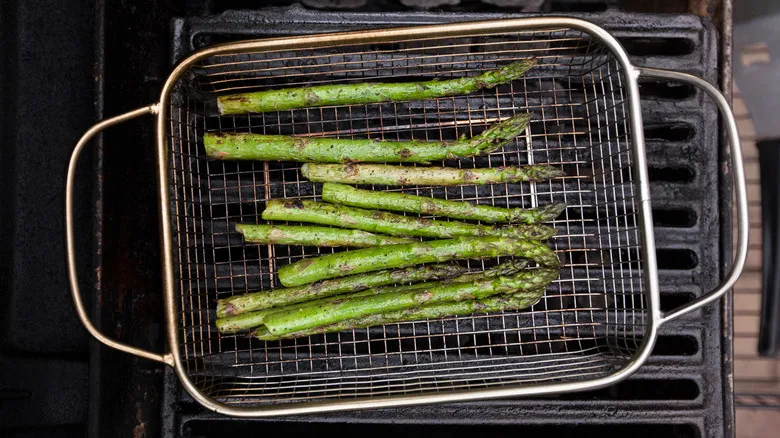
A common challenge many encounter when grilling vegetables is preventing them from falling into the flames. This is particularly problematic for smaller, chopped pieces or delicate veggies that tend to be flimsy, like perfect asparagus. Fortunately, there are a few simple solutions to tackle this problem. Chef Liam O'Connell suggests using a wire roasting rack, explaining that "it helps keep small pieces from slipping through the grates while still allowing them to grill." Unlike a sheet pan, which can obstruct direct heat and smoky flavor, a wire rack enables your vegetables to achieve that desirable char while keeping them safely elevated above the fire.
Similarly, Chef Greg León advocates for the use of a grill basket, which operates much like a wire roasting rack. He emphasizes that it is particularly beneficial for "ensuring even cooking, preventing sticking, and making it easier to handle the vegetables." Both a grill basket and a wire rack promote better heat circulation around the veggies. Additionally, utilizing these tools keeps your hands safely away from the hot grill, minimizing the risk of burns.
Keep a pot with water in it on the grill
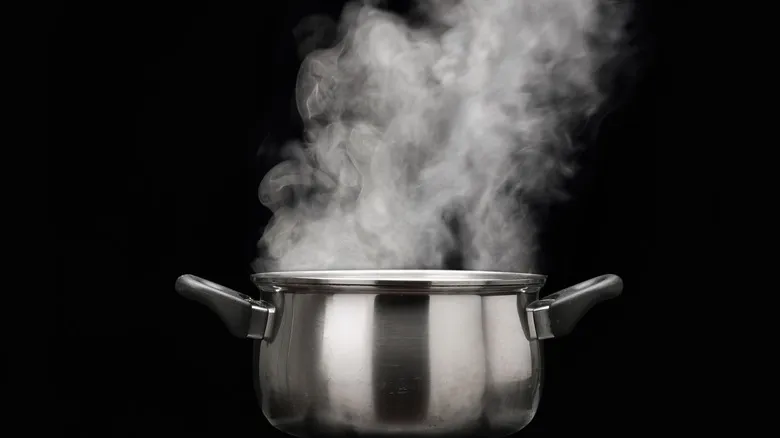
Grilling vegetables can be somewhat challenging, particularly when it comes to preserving their moisture. The intense, direct heat from the flames, which gives vegetables their appealing char, can also extract their natural juices, resulting in dryness if not monitored closely. This occurs because the high temperatures cause the water within the vegetables to evaporate quickly, leaving them shriveled, less flavorful, and more susceptible to burning.
Chef Liam O'Connell offers a straightforward yet effective solution to this problem: place a pot or pan filled with water on the grill alongside your vegetables. According to O'Connell, this will "generate steam to help them cook a bit faster in a moist environment." The additional moisture from the steam counteracts the drying effects of the grill's heat, ensuring that your vegetables retain their natural texture and flavor. This retained moisture also promotes more even cooking, particularly for thicker vegetables like sweet potatoes or carrots. As the steam surrounds the vegetables, it gently cooks them from all angles, minimizing the risk of uneven charring or undercooked centers.
Grill proteins before vegetables
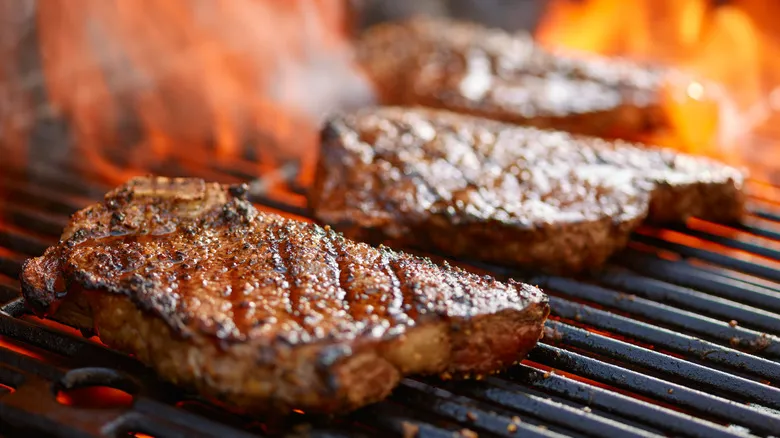
Grilling proteins before vegetables is an effective approach that can make your grilling experience more efficient, ensuring that every part of the meal is cooked to perfection and served at the right time. "Typically, I cook the proteins first and let them rest, then I move on to the vegetables. If needed, you can always return the proteins to the grill for a quick warm-up without risking overcooking," suggests Liam O'Connell. This method not only simplifies the grilling process but also elevates the overall dining experience, allowing each component of the dish to be served hot and at its finest.
Chef Greg León points out that "meats and vegetables often require different cooking times and temperatures." This discrepancy can lead to some items being overcooked if grilled together. By prioritizing proteins, you can sidestep this problem entirely. This way, you can concentrate on each part of your meal separately, ensuring that both the meat and vegetables achieve their ideal doneness.
Marinate but don't over-marinate
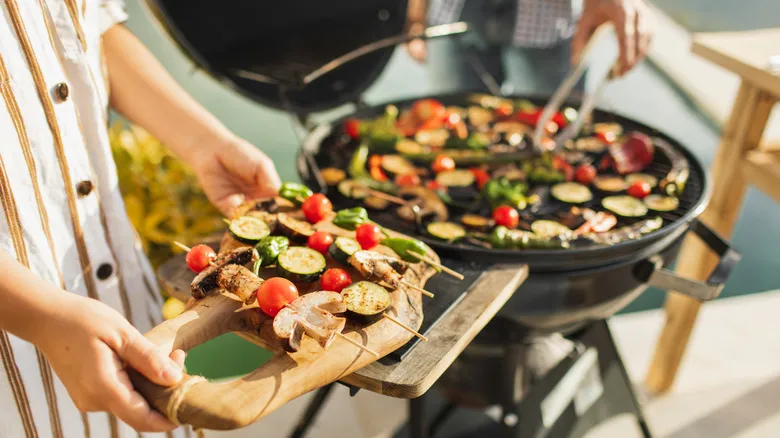
Marinating vegetables prior to grilling is a fantastic method to enhance their flavor and maintain moisture, but it's crucial to exercise moderation. Chef Greg León advises using oil sparingly. "A light application of oil aids in caramelization and reduces sticking, but excessive oil can cause flare-ups and charred areas." He also offers valuable insight regarding marinades: "Be cautious not to marinate for too long—especially with acidic mixtures—since they can render vegetables mushy." Ingredients like vinegar or citrus can weaken the vegetables' structure if left too long, resulting in an undesirable texture. León recommends marinating for 15 to 30 minutes, using just one to two tablespoons of oil per pound of vegetables. This modest amount helps the seasonings stick and encourages a pleasant char without compromising the texture of the vegetables.
Furthermore, León stresses that applying oil directly to the vegetables is much more effective than over-oiling the grill, as it "ensures even distribution and prevents sticking without excess oil dripping onto the flames." The key takeaway is to not forgo oil and marinades entirely, as they contribute flavor, prevent sticking, and promote even cooking on the grill. However, moderation is essential.
Choose the right oil
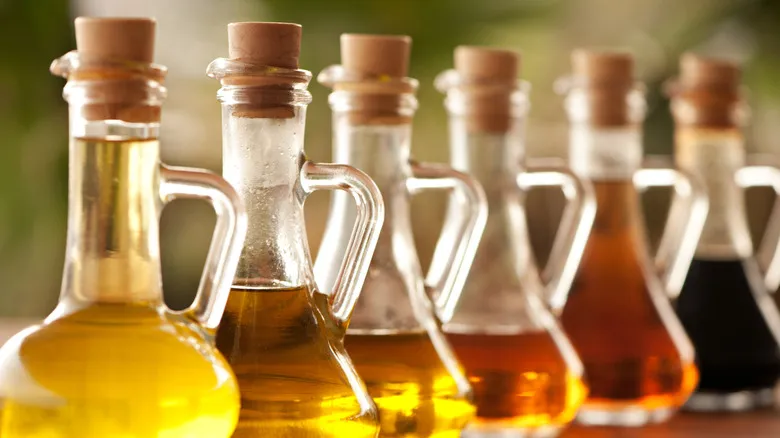
The choice of oil for grilling vegetables can significantly influence the outcome. The oil's fat content can lead to increased flames. Liam O'Connell notes that excessive oil can "trigger a flare-up that may make food appear charred, but it's really just the residual oils burning." To prevent this, opt for oils with a high smoke point—those that can endure elevated temperatures without burning or producing excessive smoke, like olive oil or avocado oil. Olive oil has a smoke point of up to 465°F, while avocado oil can reach as high as 520°F.
Additionally, "grapeseed oil is an excellent option for those who want a clean taste without overpowering the vegetables," says Chef Greg León. It has a smoke point of around 420°F and a mild, neutral flavor. Ultimately, select an oil that can withstand the heat to ensure your grilled vegetables remain tasty and free from burnt flavors, allowing their natural essence to shine.
Add acidic elements after grilling
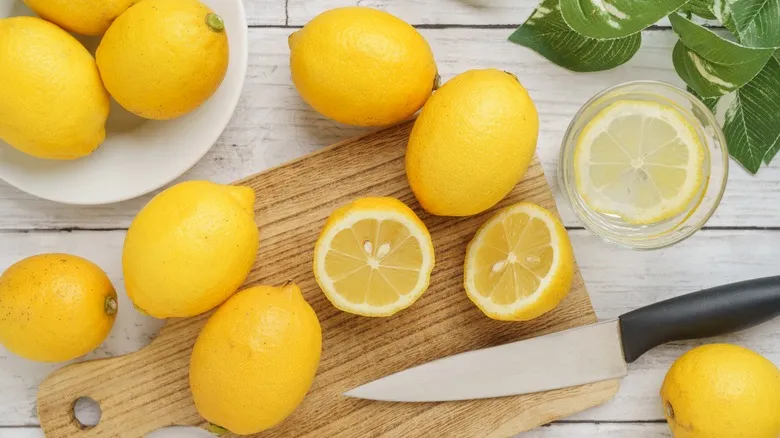
Incorporating acidic ingredients into grilled vegetables can significantly enhance their flavor and create a delightful contrast to the smoky richness imparted by the grill. However, the timing of when these acidic elements are added is crucial. Chef Greg León points out that "a splash of acid added after grilling elevates the flavor and balances the charred notes." By drizzling your vegetables with a touch of acid, such as lemon juice or balsamic vinegar, after they come off the grill, you allow the acidity to stand out without being compromised by the high heat. This finishing touch introduces a vibrant, zesty flavor that cuts through the smokiness, resulting in a well-rounded and refreshing taste.
Conversely, adding acidic ingredients before or during the grilling process can lead to undesirable outcomes. The intense heat can cause the acid to evaporate rapidly or even burn, as noted by León. When this occurs, the intended tangy and refreshing characteristics of the acid are lost, undermining the very purpose of incorporating them.
Start with a clean grill
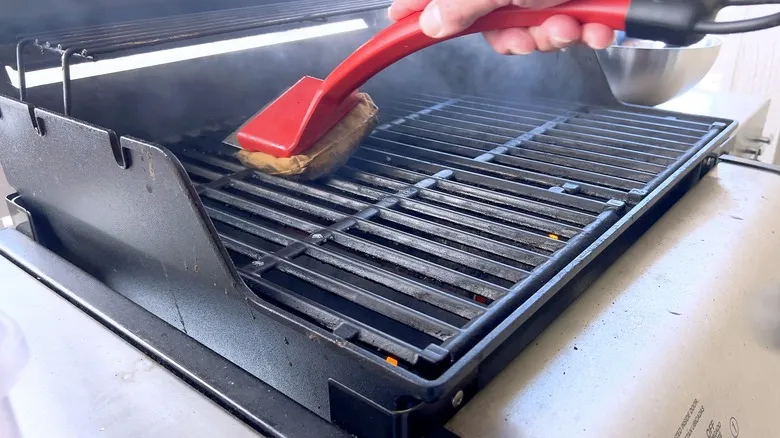
One of the most commonly neglected aspects of grilling vegetables is ensuring the grill is clean. "I always ensure my grill grates are spotless," says Chef Liam O'Connell. While it may seem like a small detail, it is essential for both flavor and the cooking process. Greg León emphasizes, "Clean grates stop residue from previous meals from sticking to the vegetables and causing undesirable flavors." No one wants their perfectly grilled asparagus or cherry tomatoes to taste like last week's burgers.
León recommends cleaning your grill after preheating it, and then using a grill brush to thoroughly scrub the grates. If you don’t have a grill brush handy, you can always use half an onion as a substitute. Regardless of what you use, be sure to eliminate any leftover food particles or grease to ensure a pristine cooking surface. A clean grill also minimizes the risk of flare-ups, which can occur when old, burnt bits break off the grates, fall into the flames, and char your vegetables.
Preheat the grill to the right temperature
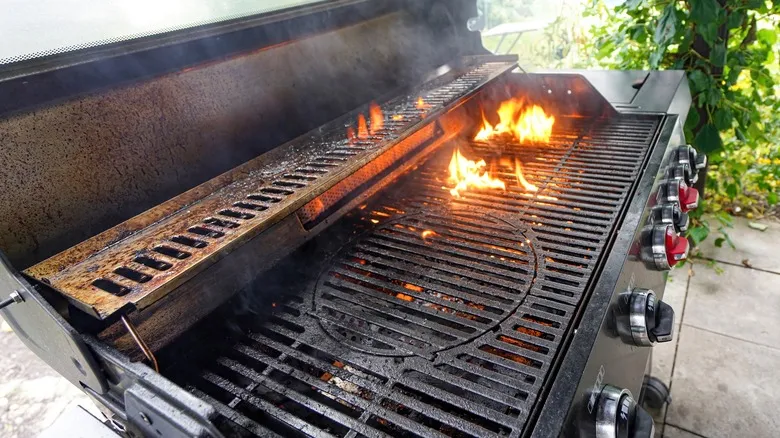
One common mistake to avoid when grilling vegetables is neglecting to preheat the grill. Chef Greg León highlights the significance of this step, stating that "Placing vegetables on a cold grill leads to inadequate searing." By preheating your grill, the vegetables come into contact with the grates at the optimal temperature, allowing them to begin cooking right away and achieve those beautiful grill marks.
The perfect temperature for grilling vegetables falls between medium and medium-high, generally around 375°F to 450°F. "This temperature range is sufficient to create a nice char and caramelization without burning the vegetables or leaving them undercooked," explains León. If your grill lacks a built-in temperature gauge, you can measure the heat using an infrared or instant-read probe thermometer. Alternatively, for charcoal grills, you can visually assess the coals: for medium heat, they should have a light layer of ash, while for medium-high heat, the coals should glow red and have a thick layer of ash.
Don't overcrowd the grill
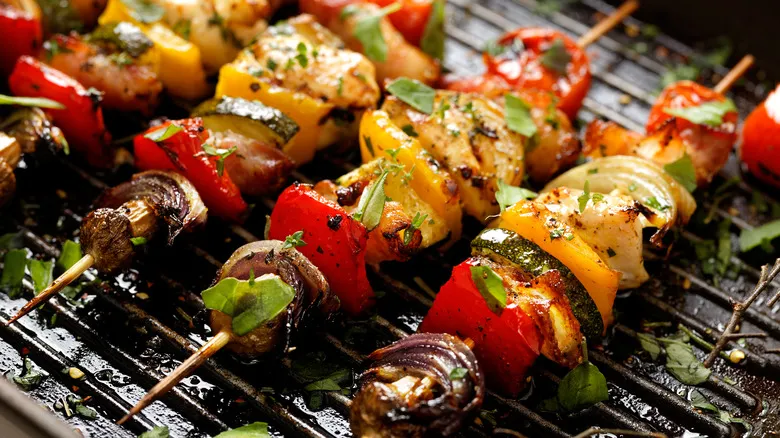
"Overloading the grill with vegetables can cause them to steam instead of grill, resulting in a soggy texture," explains Chef Greg León. The reason for this is that vegetables release moisture as they cook. When they are too tightly packed, this moisture gets trapped, creating a steam effect rather than allowing the direct heat to work effectively. This trapped moisture hinders the vegetables from developing that sought-after crispy, caramelized surface.
Additionally, a crowded grill means the vegetables won't receive the direct heat necessary for proper searing. Therefore, a crucial tip for achieving perfectly grilled vegetables is to ensure each piece has enough space for heat to circulate. León emphasizes that this allows "the grill's heat to reach all sides." For optimal results, arrange your vegetables in a single layer on the grill, leaving some space between each piece.
Recommended

Too Many Regional Styles At A Barbecue Restaurant Is An Expert Red Flag
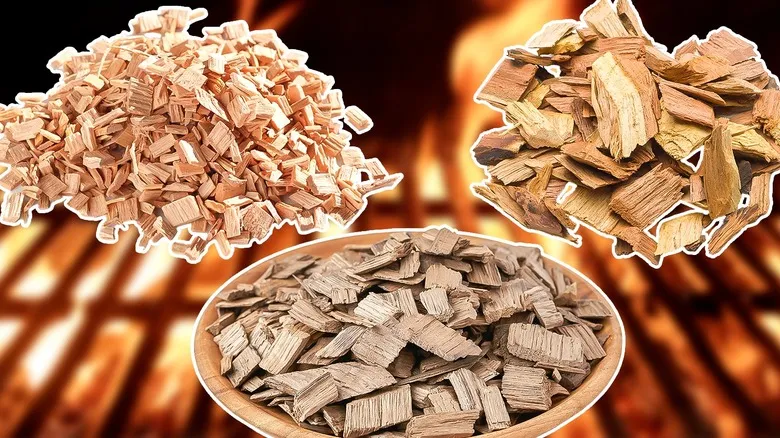
The Best Types Of Wood To Use For Smoking And Grilling

A Drizzle Of Honey Is An Easy Cheat For Satisfying Grill Marks

What Is The Difference Between Barbecuing And Grilling?
Next up


